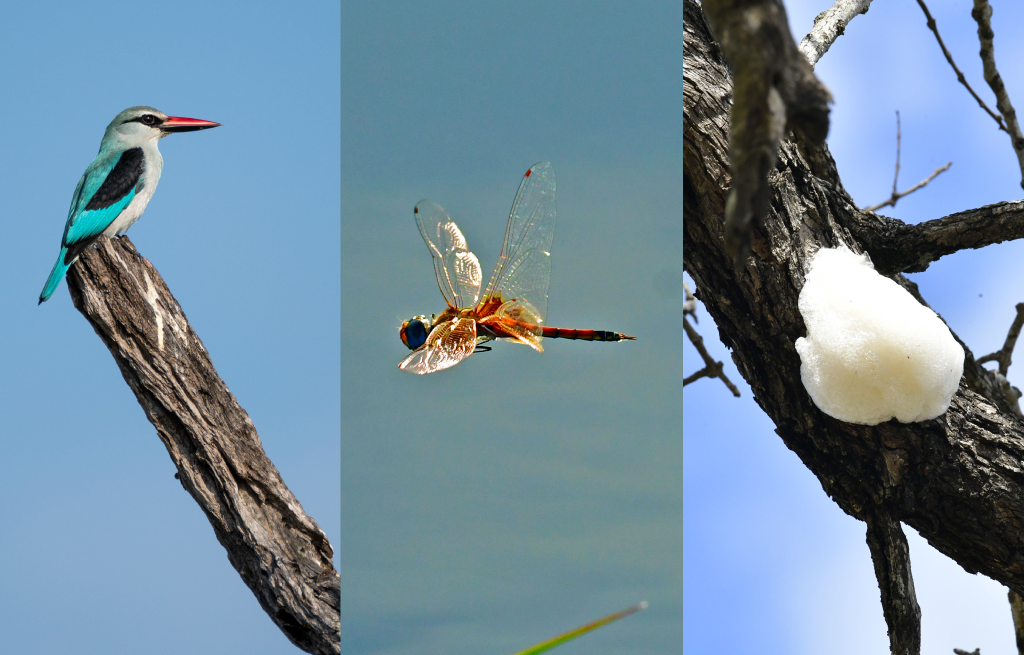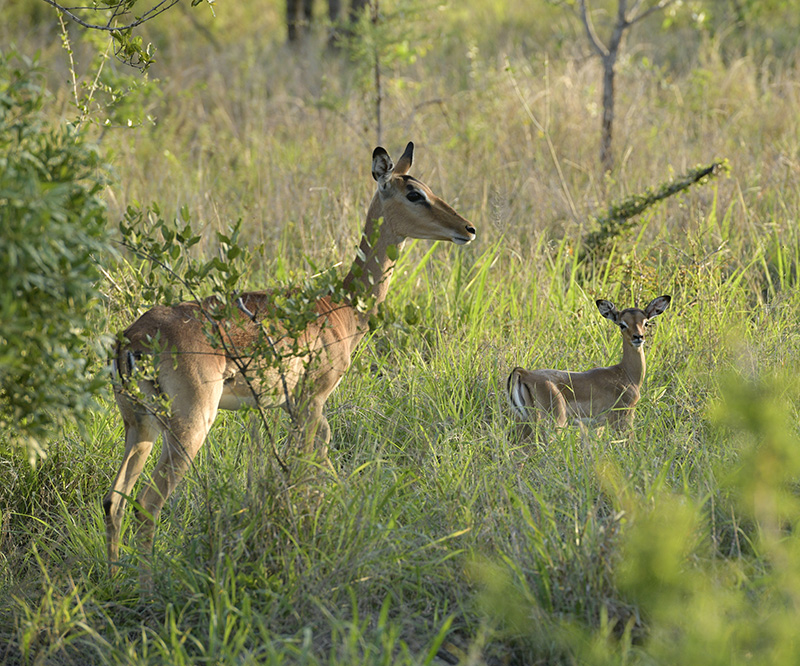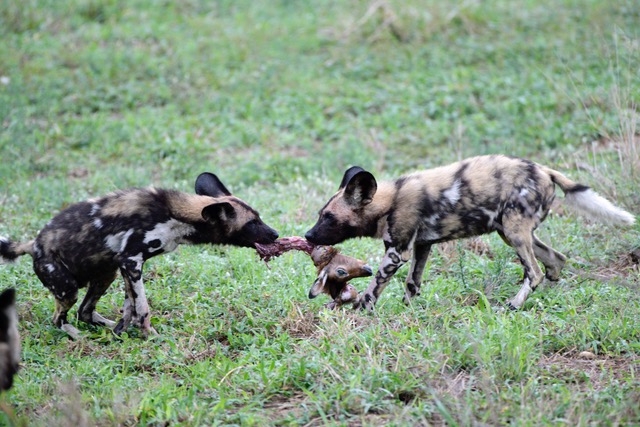
The insect world has cracked the summer dawn and it’s that time of the year again for all major forms of life to surface and reach their greatest heights!
Summer is definitely here and everything that we have been expecting is coming to life and some – it’s a rush!
Beetles, dragonflies, butterflies and many other insects are frequently seen around seasonal ponds.
Dragonflies are usually spotted above water surfaces and on the edges of waterholes and dams. After the rain it’s the time that successful mates fly together. Co-piloting their mating flight is an interesting phenomena to witness as the female attaches her abdominal claspers on the back of the male’s neck during the insemination process. When the male has inseminated the female otho-thorax, she will cut his head off and kill him, making his life relatively short!
The famous Dung beetles are everywhere, attending their dung piles and making up dung balls for food and breeding purposes.
Antelope have started dropping their babies and we were so thrilled to be able to photograph the first impala lambs this year.
Antelope drop their babies every spring / summer – generally from mid-October to December, with few cases seen much later than that. Wildebeest, Zebra, Buffalo, Kudu, Warthog and other grazing species are also on the list, so if you are on safari this summer you are sure to see their babies.

As for what you can expect to see on game drives?
Reptiles and amphibians will play a great part!
Most of the frogs and toad species breed in summer and the members from these groups will have to return to the water to complete their breeding cycle! This means that we will see and hear a lot of frogs around seasonal pools. The Southern Form-nest Frog will be making their frothy-form nests in trees or bushes hanging over static water. The mating of these species generally takes place at night time, however, we have had few sightings of these mating during the day more especially in the drizzling rain. They can lay up to 1000 eggs and once the tadpoles hatch inside the foamy cocoon will drop into the water below them to continue and complete their life cycle.
The other noticeable creatures are the Tortoises that are rather active.
We have seen a number of interactions of these species as its their breeding time. Tortoises will start moving around as water becomes more available for them and will pair up and mate over this time. The male species will appear much smaller than the female. Unlike snails, Tortoises are not hermaphrodites, so there is an obvious sexual dimorphism and only females carry eggs, which after successful fertilization, will be laid underground and covered with soil/plant material and left to hatch. And again, unlike the case of crocodiles, the warmer temperatures will hatch more females. There is also no parental care, the mother tortoise will never look after the hatchlings, they will wander on their own as individuals until maturity where they will start to attract mates and co-habit for a little while to carry on their life-cycle.
For the birders out there, our beautiful summer migrants are back and we take absolute pleasure in spotting the European Rollers at Buffalo Pan, where we stop for drinks on a drive. Purple Rollers have also been spotted in the reserve as well.
Our famous Woodland Kingfisher is also back, filling our early morning hours with beautiful “yip-treeeeeee” notes. It’s one of those calls in the wild you recognise and have affinity towards when in the bush in Summer. The Grey Go-Away birds have been seen nesting and some of them already have chicks, this is beautiful.
Some magnificent raptors like the Black-breasted Snake Eagles are also here. Just a few days ago we had a very good sighting of one fine specimen.
As highlighted in the previous report, the days have been much hotter and most of the mammals spend their days around waterholes, taking a splash or a much loved mud bath. Elephants have been seen frequenting our waterholes quite a lot and we have been blessed by many other bird species nesting around the lodge as well.

The bush has also gone green, blooming with attractive flowers and thickening with leaves and shrubs. Many flying insects like Blister beetles are spotted busy feeding on the plant nectar. Bees, flies and other birds like our common Sunbirds play a tremendous role in pollinating plants and are much needed in our ecosystem.
This is the time of the year where the food chain is essentially complete. There is a huge amount of interaction between species. Just as the many being born there are just as many that are also preyed upon. The energy cycle runs through all species, passing it from one to the next until a cycle is complete – energy can’t be destroyed or lost, it can only be transferred.

For many of you, you may have seen the extraordinary video of the death of the male lion Dark Mane. The perfect example of natural energy and the force of nature between predator and prey.
Another interesting phenomenon: termites have started sending off their larval kings and queens. These insects are attracted to the lights at night and will be seen flying around. Termites are the delicacy of frogs, snakes and scorpions that can be seen snatching these insects in delight and as termite queens are rather fat, they have a high protein content that is very nutritious to many other carnivorous animals. There are thousands of termite kings and queens released every summer and only 10 percent of these actually get to successfully breed and start new colonies, the rest are lost in the mouths of others.
Summer is beautiful and very colourful.
When taking photographs, nature favours you and your background!
Most of the animals will be active and there will be a lot of fast-moving game, so adjusting your DSLR camera to sports mode is a good option if you dont operate in manual mode.
Our guides at Cheetah Plains are familiar with DSLR cameras and are always more than happy to assist with vehicle positioning at sightings. We offer a Nikon DSLR camera on the vehicles to our guests to use while on safari which makes for capturing moments memorable. Our team is also equipped to take photo’s on your safari and share with you afterward.
This summer we are engaging on a project to photograph European bee-eater, Carmine bee-eater, Purple Roller, Woodland’s Kingfisher, mating Foam-nest Frogs, scorpions and other rare birds.
As these creatures will be active it’s going be an interesting adventure.
We have three months to complete this and we look forward to the encounters and sharing the results. Guests are welcome to take part and share their findings as well as be guided for this.
Night drives in summer can be very rewarding as temperatures will be warm and many other interesting species will be out and about. Aardvarks are known to roam their home ranges at night and can easily be spotted with a spotlight. Bush-babies (which we love) are also one of the most precious primate species to encounter. Other interesting species such as mongoose, genets, scorpions, chameleons and snakes are also to be sighted. Our afternoon drives always include a bit of an early evening drive before coming back to the villa, but it’s always recommended to do a proper one after dinner. A dark night drive when the moon is new is the best time. Summer always has that high humidity and smoky atmosphere, but we do have clear sky at times to see enough stars and the Milky Way galaxy, as well as the planets and other constellations.
It is impossible to fully describe how everything will be each season and every year is a new year with a new summer season. Nothing can ever be repeated in nature which is the beauty of experiencing the wild and your journey will also be unique. Everyone gets to see nature differently, every trip is a new trip and a new adventure… our excitement as guides lies between those lines!
Wishing you a spectacular summer season.
Sipps